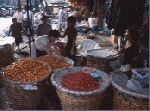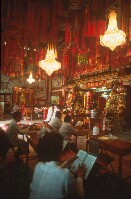BETTER IN BANGKOK: Day Three: Part 4 of 4
by Louis BignamiYAOWARAT: SHOPPING AND SEAFOOD Your last day depends on your needs, and what follows. If you plan to head upcountry you need not shop in Bangkok: prices out of the city are as much as 50% lower. Martial arts types might consider a bruising day kick boxing at the Muay Thai Institute.
Thai cooking schools abound at hotels such as the Sheraton Grande Sukhumvit our personal favorite in the heart of the shopping district, and Buddhist meditation lessons come in more flavors than the local fruit drinks. Then too, you can try the many water parks, pools and Western sports complexes. 
Marketplace
photo credit: Louis Bignami
Otherwise, it is time to consider Yaowarat, Bangkok?s unique Chinatown named after the main street, noisy, crowded and smog infested Yaowarat Road. Chinese merchants carried much of the trading load in Thailand even before Rama I kicked them off the site of what's now the Grand Palace complex. The Chinese barely moved off Rattanakosin Island, over Oang Ang Canal and into Yaowarat, the mile-long strip that runs to Odeon Circle near the Hua Lamphong Railway Station.
If you don't mind crowds of happy Thais and tourists the best time to visit falls between Saturday evening and Sunday midnight on the first weekend of the month. The couple of hundred yards of the upscale Odeon Circle end of Yaowarat Road that become pedestrian-only territory filled with lion dances, Chinese opera and much else. Any Chinese holiday fills the streets here with celebratory Chinese too.
The best time to shop is early in the day when shutters come off the shops and stands set up because many merchants believe it important to start the day with a sale. You may get a decent price if, of course, you know how to bargain and check department and craft outlet quality and prices downtown before you buy.
There's more to Yaowarat than shopping. The best late night seafood in town comes from a section of cross-street Phadungdao Road called, oddly enough in Bangkok, Soi Texas. Fresh seafood fins, creeps or crawls in tanks here so you can order whatever dish you prefer "on the shell or fin" so to speak. Chinese food is superb and you can find at least five or six regional types plus an interesting sort of "Thai-Chai."
Chinese Temples come in many flavors such as the "model delights" of Wat Mae Lao Fang. It is named after the owner of a house where ladies of the evening prospered; naturally the Thais call it Wat Kanikaphon. Chinese burn paper models of Mercedes and such, and offer the spirits of food to newly deceased relatives here. After the spirit essence of the food leaves it's apparently okay to eat the earthly remains of Peking Duck and such.
There are Taoist temples, Buddhist temples of both Mahayana and Theravada flavors and the most interesting Wat Traimit that holds a five ton gold Buddha discovered when its stucco covering cracked during a 1950s move. Most temples feature red walls-- red is a lucky color for the Chinese -- wonderful paintings, golden hangings, huge candles and plates of food and other offerings. The best way to enjoy these is, I think, is to simply wander side streets that seem safe save for the odd pickpocket.  The variety of craft and gold shops, temples, stores, restaurants, antique and second stores crammed onto Yaowarat Road and side streets such as Sampheng Lane boggles! Some of the best deals in town are here, if you bargain. Most locals agree that the Klong Ong Ang Market has the best textile prices in Bangkok. Further along Yaowarat Sampang and Klong Thom Markets offer electronics, bootleg software and music tapes, automobile parts, watches of variable reliability like and much else. Khlong Thom has, sad to say, long since been disappeared under streets where traffic, on a good day, moves 5 mph. On weekends things get even wilder. Stands and stalls almost completely fill the sidewalk and bargaining rages in at least six languages. There is another change after dark with a switch to food stands that stay open all night for Thai men who, cynics claim, take full advantage of the double standard. Yaowarat gets more upscale after you pass Talad Kao or the "Old Market" which has more kinds of Chinese ingredients than I could find on a recent Beijing trip. If you want dried shark's fins and bird's nests this is the place. If you'd rather have them as hot soup just head a block or two down the street for lunch. Follow the advice of a sign I saw in Beijing and "Be Bravers" enough to head down Isranuphap Road to Charoenkrung Road and the massive Dragon Shrine and Wat Mangkorn, the biggest Mahayana monastery in Thailand. Maximal "Bravers" follow Sampheng Lane from Wat Pathum Khongka as it takes a semi-subterranean -- well, at least covered -- course that roughly parallels Yaowarat Road back towards Ong Ang.
The variety of craft and gold shops, temples, stores, restaurants, antique and second stores crammed onto Yaowarat Road and side streets such as Sampheng Lane boggles! Some of the best deals in town are here, if you bargain. Most locals agree that the Klong Ong Ang Market has the best textile prices in Bangkok. Further along Yaowarat Sampang and Klong Thom Markets offer electronics, bootleg software and music tapes, automobile parts, watches of variable reliability like and much else. Khlong Thom has, sad to say, long since been disappeared under streets where traffic, on a good day, moves 5 mph. On weekends things get even wilder. Stands and stalls almost completely fill the sidewalk and bargaining rages in at least six languages. There is another change after dark with a switch to food stands that stay open all night for Thai men who, cynics claim, take full advantage of the double standard. Yaowarat gets more upscale after you pass Talad Kao or the "Old Market" which has more kinds of Chinese ingredients than I could find on a recent Beijing trip. If you want dried shark's fins and bird's nests this is the place. If you'd rather have them as hot soup just head a block or two down the street for lunch. Follow the advice of a sign I saw in Beijing and "Be Bravers" enough to head down Isranuphap Road to Charoenkrung Road and the massive Dragon Shrine and Wat Mangkorn, the biggest Mahayana monastery in Thailand. Maximal "Bravers" follow Sampheng Lane from Wat Pathum Khongka as it takes a semi-subterranean -- well, at least covered -- course that roughly parallels Yaowarat Road back towards Ong Ang.
The remainder of Yaowarat offers at least 30 shops selling gold chains and jewelry at lower prices than downtown. After all this walking it's time to consider a Tuk-Tuk, a sort of a loud, open three-wheel motor rickshaw you've been eyeing all this time. Have a good idea of where you want to go -- The National Museum is not far -- and an agreement on the fare before you get in the cab. Expect to pay 15 to 50 baht for a reasonably short ride. If you want to go far and fast, and your insurance coverage obtains, consider a motorcycle "taxi." You sit behind the driver with a helmet and orange jumper and he threads between the stalled traffic at least most of the time.
Fit and frisky folks might want to consider a Thai workout. We always end our trips in Thailand with dinner at the Bussaracum, a wonderful restaurant at a very famous school of Thai Court cooking. "If you have to ask how much it costs, you can't afford it," but you need reservations.
TRIPPING BACK
Then, on the 18 and a half-hour flight back to the United States, plot your early return. There's so much left to see in Bangkok, and even more to do in Thailand where the 60 baht to the dollar exchange rate makes the country most affordable. Then too, consider the rest of the country has only 10% of the cars usually stalled in Bangkok and buses and the best trains are comfortable and cheap, and it is clear your next, or first, trip should include three or four days in, and at least a week outside, the most exotic big city in Asia. Wonderful highlands, several beach resorts and some of the best national parks in Southeast Asia justify a longer visit.
